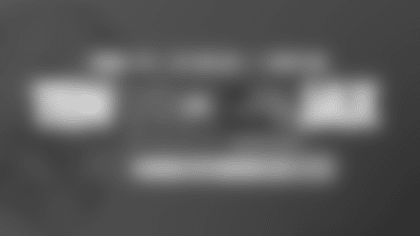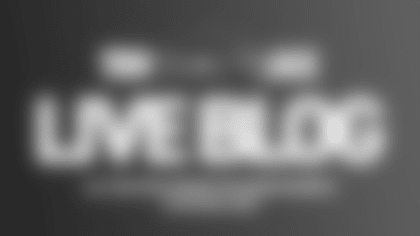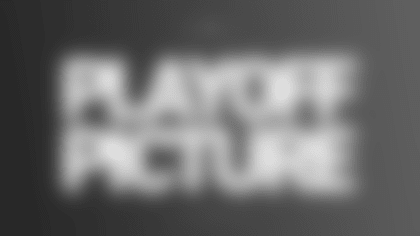Join jaguars.com Senior Editor Vic Ketchman as he tackles the fans' tough questions.
Gene from Keystone Heights, FL:
Can we enter your car into MTV's "Pimp My Ride?" You would look phat with a killer set of rims.
Vic: I don't think my Nissan Sentra would win.
Javier from Hammonton, NJ:
According to your poll: Which best describes your draft philosophy? Thirty-three percent said best available player, 29 percent said find a play-maker and 20 percent said to draft by need. That's bull. Before you made the case of drafting the best available player, I'm sure over half of those people thought drafting the player of need was the top priority. You have obviously influenced at least 33 percent of us fans. I commend you on that. Anyway, who do you think will have the biggest impact from the draft to the NFL this year?
Vic: Larry Fitzgerald and Roy Williams would certainly be in position to have major impacts on the teams that draft them. The wide receiver position offers that kind of right-away potential. So does running back and pass-rusher. Another player who could have a major impact as a rookie is cornerback DeAngelo Hall, who also doubles as a kick-returner. Hall has the kind of athletic ability and play-maker skills to be a burst-onto-the-scene kind of player.
David from Woodbridge, VA:
You use the term "possession" receiver frequently. I assume this isn't the number one receiver; the Jimmy Smith type. What exactly does "possession" receiver mean? What are the other receiver types, and who on the Jaguars roster filled each role last year?
Vic: Forget about last season, because last year's wide receiver corps never really defined the roles of its players. Let's go back to the Jaguars' hey-day, when Jimmy Smith and Keenan McCardell represented one of the best pass-catching combinations in the league. Smith was the Jaguars' number one receiver (X) and McCardell was the number two guy (Z or slot receiver). Number one receivers are stretch-the-field types. They represent a team's "home run hitter." That was Smith. Number two receivers are curl-up, find-soft-spots-in-the-zone guys who make the catch and keep the drive going. That was McCardell. Number one receivers have speed, are more feared by opponents and are generally considered to be more difficult to find and, therefore, are more valued. No one denies the value of the "possession" role, but it's widely accepted that it's easier to find those kinds of receivers. In other words, rule of thumb is you draft number one receivers early, then find the "possession" guys in the later rounds. The challenge is being able to predict whether a player is going to be a number one or a number two receiver. Keyshawn Johnson was the first pick of the 1996 draft, and some people would say that was a mistake because Johnson is a "possession" receiver.
Justin from Jacksonville:
If it came down to Roy Williams or Kenechi Udeze, who do you select. I say Roy Williams all the way.
Vic: My guess is that Roy Williams is higher on draft boards than Kenechi Udeze, and I believe firmly in drafting the highest-rated player.
Troy from Murrieta, CA:
You asked earlier if there was any team in the AFC South with whom the Jaguars would trade rosters and you said no. How about in the entire NFL? If so, which teams would you trade rosters with?
Vic: There are certainly teams that have stronger rosters than the Jaguars, but when I say trade rosters with another team, you also trade for that team's salary cap. And there are other factors. For example, I think New Orleans has a strong roster, but the Saints don't have the future at quarterback the Jaguars have, therefore, I'd be reluctant to trade rosters with the Saints. Anyhow, these are the teams in the NFL whose rosters and accompanying salary caps I consider to be attractive: New England, Buffalo, Cincinnati, Jacksonville, Houston, Philadelphia, Dallas, Carolina, New Orleans, Atlanta, Minnesota and Seattle.
David from Glendale, CA:
I read on titans.com that they might release Eddie George. How much money would they save and how big of a hit would it be? I don't think the salary cap is good in Tennessee, yet, but are they making the right steps toward having a friendly salary cap?
Vic: There's only one way to fix a salary cap that's in as bad of shape as the Titans' is: Gut the roster. In my opinion, to do it any other way is only to waste time. Maybe a team can remain competitive by moving money around and trying to buy time, but there will be a slow deterioration, during which the team can't realistically aspire to anything more than mediocrity. In the case of Eddie George, the Titans would realize a $4.25 million salary cap savings this year by cutting George after June 1, but the big problem is 2005. Did you read "Salary Cap 101?" If you had, you might remember the June 2 rule: What's in the year stays in the year; everything else goes into next year. Here's the breakdown on George: He's scheduled to be a $7.3 million salary cap hit this year. The Titans will save his $4.25 million salary, but must accept his $2.06 million bonus amortization and $1 million roster bonus as $3.05 million in "dead money." By the way, that roster bonus is a perfect example of the kind of bad business decision a team in cap trouble has to make. The Titans had to pay George the roster bonus because their cap would not permit them to take the full amortization hit this year; they have to wait until June, if they're going to cut George. And if that's what they do, the Titans will realize a $4.1 million "dead money" hit on their '05 salary cap. That'll be George's remaining amortization.













